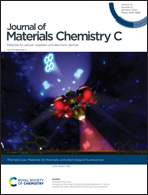Toward rational design of TADF two-coordinate coinage metal complexes: understanding the relationship between natural transition orbital overlap and photophysical properties†
Abstract
A series of twelve two-coordinate coinage metal, Cu, Ag and Au, complexes with carbene-metal-amide structures were prepared. The complexes all display thermal assisted delayed fluorescence (TADF) emission at room temperature from interligand charge transfer (ICT) excited state with short lifetimes (less than 2 μs) and photoluminescent quantum yields that reach near unity. Owing to the involvement of the substituents in the emissive transitions and different metal ion volume, the natural transition orbital (NTO) overlap of the emissive state can be adjusted in a wide range from 0.21 to 0.41. Investigations on the relationship between the NTO overlap of the emissive state and key TADF photophysical properties demonstrated that both singlet–triplet energy gap and radiative decay rate of S1 state increase along with the NTO overlap exponentially. Consequently, the overall TADF radiative decay rate leads to a maximum when plotted against the NTO overlap, giving the ideal zone from 0.25 to 0.30 for high TADF radiative decay rate in this class of two-coordinate coinage metal complex luminophores.

- This article is part of the themed collection: Materials for thermally activated delayed fluorescence and/or triplet fusion upconversion


 Please wait while we load your content...
Please wait while we load your content...